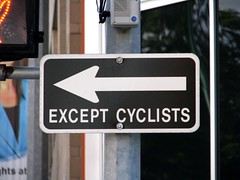The purpose of a downtown one-way street system is to get vehicles into and out of the central business district as efficiently as possible. Cities that are now trying to recreate pedestrian / resident / small shop friendly streetscapes in their downtowns are finding that it is difficult to do with a four-lane mini-highway out front.
Winnipeg didn't convert its main streets to one-ways, as was the case with Vancouver WA or Brandon's Rosser and Princess Streets, but like most North American cities in the 1950's it converted many of its secondary downtown streets to the 'more modern' traffic practice.
The popularity of motorized vehicles put pressure on the city's small-town street system. As early as the mid-1920s, Winnipeg had partial one-way streets to deal with traffic congestion at busy locations.
William Avenue between Main and King streets was a one-way for most of the day to allow access to the public market building. Lombard Avenue became an eastbound one-way on weekday afternoons to prevent cars funnelling onto Portage Avenue during the afternoon rush hour.
The first permanent one-way was Glenwood Crescent in Elmwood in 1930. Residents became tired of motorists using it as a scenic shortcut to get from the city to the beach district.
In July 1931, the city introduced sweeping changes to the streets bylaw that included allowing right turns at red lights and converting most diagonal parking to parallel parking. It also banned turns at Donald and Portage and created three partial one-way streets in the downtown. (The section of Maryland Street mentioned in the above image became from Broadway southbound to the Maryland Bridge.)
As more people moved to the suburbs after the Second World War and commuted to the downtown by car each day, calls for the city to convert more streets to one-ways appeared regularly in the newspapers. Some residents wanted certain regional streets, even their own residential street, made one-way as they felt it would increase parking and decrease traffic flow.
In 1950, a plan was devised to convert most of the city's downtown north-south running streets into one-ways.
Interestingly, even the Downtown Business Association was on board with the plan though many individual businesses owners who would be impacted were not. It acknowledged that the one-way would come with restrictions on parking and loading zones on many streets. Still, it felt increasing the flow of traffic into and out of downtown was a positive move and that new surface parking lots, some financially supported by the city, would become the new norm for those wanting to spend time downtown.
The one-way plan was implemented in two stages with Donald / Princess and Smith / King streets converted on Sunday, June 27, 1954. A number of new turn restrictions were also added. Shaded sections on the map above indicate new time-restricted parking zones. These streets were chosen first as they were part of the traffic plan for the new Midtown Bridge which would open the following year.
The remaining north- south streets were to be converted in the summer of 1955, but financial issues got in the way.
The city was fine with covering the costs of switching around traffic lights, hundreds of street signs and rebuilding some traffic islands, but the biggest expense was moving the poles and overhead wires for the trolley buses that ran through the downtown. The city and transit commission entered negotiations and figured out a cost-sharing scheme by the spring of 1956.
On Sunday, August 26, 1956, the remaining downtown streets were converted. Traffic on Garry, Donald, Carlton and Kennedy streets now went southbound and Fort, Smith, Hargrave, and Edmonton went northbound.
The first days came and went with some confusion but no major mishaps. A longer-term problem was that drivers were unable to figure out how to make turns off a one-way street. The Free Press helped out with a series of diagrams on their front page a month later.
There were some major additions to the one-way system over time.
In 1961, St. Mary and York avenues were made one-ways to deal with traffic congestion related to the Osborne Bridge.
Later that decade, Sherbrook and Maryland became full one-ways due to new traffic schemes such as the Cumberland corridor and The Sherbrook-McGregor overpass, which never materialized.
Update:
My 2021 Free Press column about the system turning 65 !
Related:
One-way downtown streets a legacy of post-war growth Winnipeg Free Press
The case against one-way streets Bloomberg CityLab
Do two-way streets help a city's economy? Bloomberg CityLab














.bmp)


4 comments:
I totally agree that there is an excess of one way streets in Winnipeg.
My personal feeling is that the we should go back to the drawing board and start dropping various streets in the city from one way status.
Good find.
That would be a good idea to look at. One-ways, streets where you inexplicably cannot turn left (especially outside rush-hour times) ... so much has changed in 50 years yet the overall street pattern hasn't.
Great research. Thank you. Very interesting to see how long our self inflicted woulds have been happening. Its like the city became a machine for moving cars almost the instant they were invented. Just another nail in downtown's coffin that most people are oblivious to.
Ok...so THAT'S why I saw a photo of Lombard Avenue from the late 30s-early 40s, showing all of the traffic and parked vehicles pointing the same way (east)! It must have been one of the original 3 to go one-way, then get switched back, like Albert was.
Post a Comment